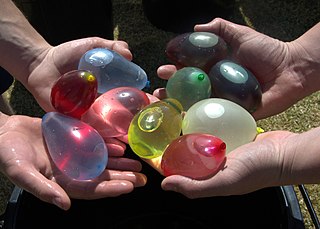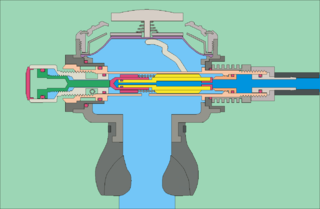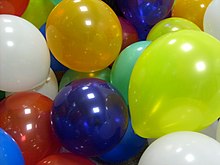
Choking, also known as foreign body airway obstruction (FBAO), is a phenomenon that occurs when breathing is impeded by a blockage inside of the respiratory tract. An obstruction that prevents oxygen from entering the lungs results in oxygen deprivation. Although oxygen stored in the blood and lungs can keep a person alive for several minutes after breathing stops, choking often leads to death.

A water balloon or water bomb is a balloon, often made of latex rubber, filled with water. Water balloons are used in a summer pastime of cooling off through water balloon fights. Water balloons are also popular for celebrations, including celebrating Holi and Carnival in India, Nepal, and several other countries.

A dry suit or drysuit provides the wearer with environmental protection by way of thermal insulation and exclusion of water, and is worn by divers, boaters, water sports enthusiasts, and others who work or play in or near cold or contaminated water. A dry suit normally protects the whole body except the head, hands, and possibly the feet. In hazmat configurations, however, all of these are covered as well.

An inflatable is an object that can be inflated with a gas, usually with air, but hydrogen, helium, and nitrogen are also used. One of several advantages of an inflatable is that it can be stored in a small space when not inflated, since inflatables depend on the presence of a gas to maintain their size and shape. Function fulfillment per mass used compared with non-inflatable strategies is a key advantage. Stadium cushions, impact guards, vehicle wheel inner tubes, emergency air bags, and inflatable space habitats employ the inflatable principle. Inflation occurs through several strategies: pumps, ram-air, blowing, and suction.

Standard diving dress, also known as hard-hat or copper hat equipment, deep sea diving suit or heavy gear, is a type of diving suit that was formerly used for all relatively deep underwater work that required more than breath-hold duration, which included marine salvage, civil engineering, pearl shell diving and other commercial diving work, and similar naval diving applications. Standard diving dress has largely been superseded by lighter and more comfortable equipment.

Circular breathing is a breathing technique used by players of some wind instruments to produce a continuous tone without interruption. It is accomplished by inhaling through the nose while simultaneously pushing air out through the mouth using air stored in the cheeks.

A full-face diving mask is a type of diving mask that seals the whole of the diver's face from the water and contains a mouthpiece, demand valve or constant flow gas supply that provides the diver with breathing gas. The full face mask has several functions: it lets the diver see clearly underwater, it provides the diver's face with some protection from cold and polluted water and from stings, such as from jellyfish or coral. It increases breathing security and provides a space for equipment that lets the diver communicate with the surface support team.

Balloon modelling or balloon twisting is the shaping of special modelling balloons into various shapes, often balloon animals. People who create balloon animals and other twisted balloon decoration sculptures are called twisters, balloon benders, and balloon artists. Twisters often perform in restaurants, at birthday parties, fairs and at public and private events or functions.

A pressure suit is a protective suit worn by high-altitude pilots who may fly at altitudes where the air pressure is too low for an unprotected person to survive, even when breathing pure oxygen at positive pressure. Such suits may be either full-pressure or partial-pressure. Partial-pressure suits work by providing mechanical counter-pressure to assist breathing at altitude.
A balloon rocket is a rubber balloon filled with air or other gases. Besides being simple toys, balloon rockets are a widely used as a teaching device to demonstrate basic physics.

A stress ball or hand exercise ball is a malleable toy, usually not more than 7 centimetres (2.8 in) in diameter. It is squeezed in the hand and manipulated by the fingers, ostensibly to relieve stress and muscle tension or to exercise the muscles of the hand.

A snorkel is a device used for breathing atmospheric air when the wearer's head is face downwards in the water with the mouth and the nose submerged. It may be either a separate unit, or integrated into a swimming or diving mask. The integrated version is only suitable for surface snorkeling, while the separate device may also be used for underwater activities such as spearfishing, freediving, finswimming, underwater hockey, underwater rugby and for surface breathing while wearing scuba equipment. A standard snorkel is a curved tube with a shape usually resembling the letter "L" or "J", fitted with a mouthpiece at the lower end and made from plastic, synthetic elastomers, rubber, or light metal. The snorkel may have a loop or a clip to attach it to the head strap of the diving mask or swimming goggles, or may be tucked between the mask-strap and the head. Some snorkels are fitted with a float valve at the top to prevent flooding if the top opening is immersed, and some are fitted with a water trap and purge valve, intended for draining water from the tube.

Latex is an emulsion of polymer microparticles in water. Latexes are found in nature, but synthetic latexes are common as well.

A balloon is a flexible membrane that can be inflated with a gas, such as helium, hydrogen, nitrous oxide, oxygen, and air. For special tasks, balloons can be filled with smoke, liquid water, granular media, or light sources. Modern day balloons are made from materials such as rubber, latex, polychloroprene, or a nylon fabric, and can come in many different colors. Some early balloons were made of dried animal bladders, such as the pig bladder. Some balloons are used for decorative purposes or entertaining purposes, while others are used for practical purposes such as meteorology, medical treatment, military defense, or transportation. A balloon's properties, including its low density and low cost, have led to a wide range of applications.

Foreign body aspiration occurs when a foreign body enters the airway which can cause difficulty breathing or choking. Objects may reach the respiratory tract and the digestive tract from the mouth and nose, but when an object enters the respiratory tract it is termed aspiration. The foreign body can then become lodged in the trachea or further down the respiratory tract such as in a bronchus. Regardless of the type of object, any aspiration can be a life-threatening situation and requires timely recognition and action to minimize risk of complications. While advances have been made in management of this condition leading to significantly improved clinical outcomes, there were still 2,700 deaths resulting from foreign body aspiration in 2018. Approximately one child dies every five days due to choking on food in the United States, highlighting the need for improvements in education and prevention.

Shooting targets are objects in various forms and shapes that are used for pistol, rifle, shotgun and other shooting sports, as well as in darts, target archery, crossbow shooting and other non-firearm related sports. The center is often called the bullseye. Targets can for instance be made of paper, "self healing" rubber or steel. There are also electronic targets that electronically can provide the shooter with precise feedback of the shot placement.

The term kamifūsen refers to several types of paper balloons in Japanese culture. They are simple toys for children, advertising give-aways for traditional medicine companies, and illuminated flying balloons at festivals.

The mechanism of diving regulators is the arrangement of components and function of gas pressure regulators used in the systems which supply breathing gases for underwater diving. Both free-flow and demand regulators use mechanical feedback of the downstream pressure to control the opening of a valve which controls gas flow from the upstream, high-pressure side, to the downstream, low-pressure side of each stage. Flow capacity must be sufficient to allow the downstream pressure to be maintained at maximum demand, and sensitivity must be appropriate to deliver maximum required flow rate with a small variation in downstream pressure, and for a large variation in supply pressure, without instability of flow. Open circuit scuba regulators must also deliver against a variable ambient pressure. They must be robust and reliable, as they are life-support equipment which must function in the relatively hostile seawater environment, and the human interface must be comfortable over periods of several hours.






















